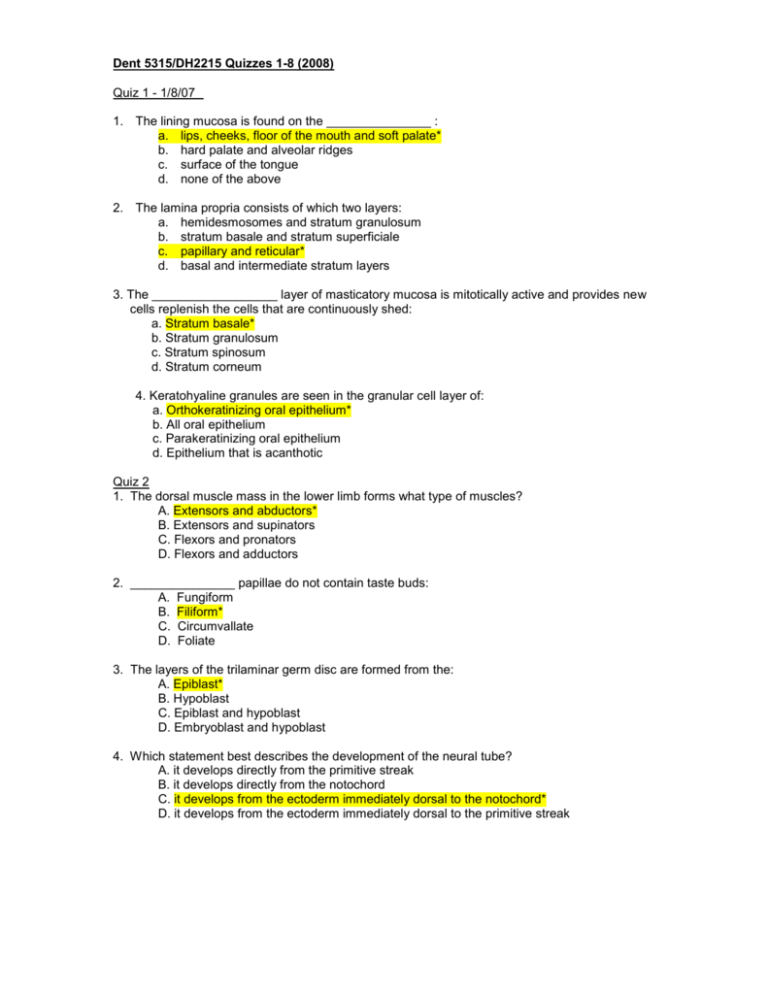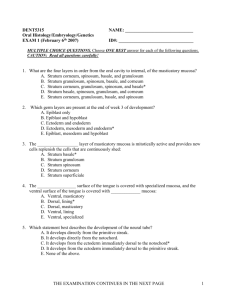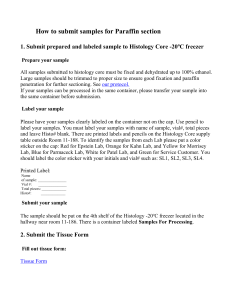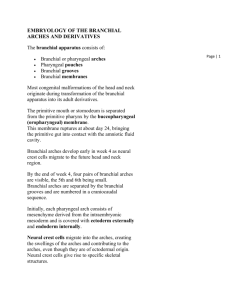Quizzes 1-8 (2008)
advertisement

Dent 5315/DH2215 Quizzes 1-8 (2008) Quiz 1 - 1/8/07 1. The lining mucosa is found on the _______________ : a. lips, cheeks, floor of the mouth and soft palate* b. hard palate and alveolar ridges c. surface of the tongue d. none of the above 2. The lamina propria consists of which two layers: a. hemidesmosomes and stratum granulosum b. stratum basale and stratum superficiale c. papillary and reticular* d. basal and intermediate stratum layers 3. The __________________ layer of masticatory mucosa is mitotically active and provides new cells replenish the cells that are continuously shed: a. Stratum basale* b. Stratum granulosum c. Stratum spinosum d. Stratum corneum 4. Keratohyaline granules are seen in the granular cell layer of: a. Orthokeratinizing oral epithelium* b. All oral epithelium c. Parakeratinizing oral epithelium d. Epithelium that is acanthotic Quiz 2 1. The dorsal muscle mass in the lower limb forms what type of muscles? A. Extensors and abductors* B. Extensors and supinators C. Flexors and pronators D. Flexors and adductors 2. _______________ papillae do not contain taste buds: A. Fungiform B. Filiform* C. Circumvallate D. Foliate 3. The layers of the trilaminar germ disc are formed from the: A. Epiblast* B. Hypoblast C. Epiblast and hypoblast D. Embryoblast and hypoblast 4. Which statement best describes the development of the neural tube? A. it develops directly from the primitive streak B. it develops directly from the notochord C. it develops from the ectoderm immediately dorsal to the notochord* D. it develops from the ectoderm immediately dorsal to the primitive streak Quiz 3 (1/22/08) 1. A 3 month-old baby girl presents with a swollen umbilicus that has failed to heal normally. The umbilicus drains secretions, and there is passage of urine through the umbilicus at times. What is the most likely diagnosis? A. Omphalocele B. Gastroschisis C. Meckel’s diverticulum D. Patent urachus* 2. Which of the following arteries supplies midgut derivatives of the digestive system? A. Celiac trunk artery B. Superior mesenteric artery* C. Inferior mesenteric artery D. Intercostal artery 3. In the fetal heart, the foramen ovale connects the: A. pulmonary artery and the aorta. B. right and the left atria, permitting the flow of blood from right to left. C. right and the left atria, permitting the flow of blood from left to right. D. right and the left ventricles, permitting the flow of blood from right to left.* E. right and the left ventricles, permitting the flow of blood from the left to right. 4. The ureteric bud gives rise to the: A. collecting duct system* B. nephrons C. collecting duct system and nephrons D. None of the above Quiz 4 (1/29/08) 1. Embryonic connective tissue in the head is derived from: A. Mesoderm B. Endoderm C. Notocord D. Neuroectoderm* 2. The outer aspect of all branchial arches is covered by ectoderm and the inner aspect of all branchial arches is covered by endoderm. A. True B. False* 3. Which branchial arch arteries give rise to the majority of the vessels that supply blood to the head and neck? A. Branchial arch arteries 1 B. Branchial arch arteries 2 C. Branchial arch arteries 3* D. Branchial arch arteries 4 4. What branchial arch gives rise to muscles that are innervated by the facial cranial nerve (VII)? A. Branchial arch 1 B. Branchial arch 2* C. Branchial arch 3 D. Branchial arch 4 QUIZ 5 (2/12/08) 1. Enamel rods A. are present in ivory. B. contain hydroxyapatite crystals. C. are made up of crystalline magnesium phosphate. D. have a composition that is 96% organic and 4% inorganic. E. have a hollow center. 2. The major function of ruffle-ended ameloblasts in the maturation stage is to A. introduce water and organic material into enamel matrix. B. alter the trajectory of enamel rods. C. allow incorporation of inorganic material into enamel. D. form Tomes' process. E. permit exit of protein fragments and water from enamel. 3. Which of the following is used as a marker to identify osteoclasts: A. Tartrate-resistant alkaline phosphatase B. Tartrate-resistant acid phosphatase C. Alkaline phosphatase D. Bone sialoprotein E. Osteoclacin 4. A major function of osteoblast is to: A. Secrete predominantly type III collagen matrix that mineralizes B. Secrete predominantly type V collagen matrix that mineralizes C. Resorb bone D. Transduce stress signals to biological activity E. None of the above Quiz 6 (2/19/08) 1.Which one of the following project a short distance from the DEJ into enamel? A. lamellae B. tufts* C. perikymata D. striae of Retzius E. Hunter-Schreger bands 2.Ridges on the surface of enamel due to the striae of Retzius are called A. lines of von Ebner. B. lines of Owen. C. Hunter-Schreger bands. D. gnarled enamel. E. perikymata. * 3.Extensions of dentinal tubules that cross into enamel are called A. dentinal spindles. B. tufts. C. enamel spindles.* D. lamellae. E. neonatal lines. 4.The first sign of dentin formation A. is von Korff's fibers.* B. is present at the cervical loop. C. occurs in the cap stage. D. occurs in the bud stage. E. is Hertwig's epithelial root sheath. Quiz 7 (2/26/08) 1.Dead tracts: A. are empty enamel rods that appear black B. result from a loss of odontoblastic processes.* C. occur primarily within the irritated dental pulp. D. originate in Hertwig’s epithelial root sheath 2. What are intrinsic fibers of cementum? A. Fibers produced by cementoblasts* B. Noncalcified fibers associated with the attachment of periodontal ligament fibers C. Principal fibers of the PDL D. None of the above 3.Perforating fibers consisting of collagen fibers embedded in alveolar bone proper are known as: A. Gingival fibers B. Sharpey’s fibers* C. Transseptal fibers D. Alveolar fibers 4. The calcified bodies sometimes found in the periodontal ligament are BEST described as which of the following? A. Cementicles* B. Denticles C. Bone D. Enamel pearls Quiz 8 (3/4/08) 1. Which of the following groups of fibers has a cementum to cementum attachment? A. Oblique B. Transseptal* C. Free gingival D. Interradicular E. Dentoalveolar 2. The terminal portion of the salivary ductal system that are in contact with serous cells is called: A. Intercalated duct* B. Excretory duct C. Striated duct D. Stensons duct 3. All of the following are true about myoepithelial cells EXCEPT: A. Function as muscle cell by squeezing the acinus and facilitating secretion B. Presnt in both acini and intercalated duct C. Is mesodermal in origin* D. Ultrastructurally similar to that of muscle cells 4. The gubernacular canal: A. Delineates a pathway for an erupting tooth* B. Is involved in posteruptive tooth movement C. Readjusts the position of the tooth socket D. Draws neighboring teeth together and maintains them in contact







